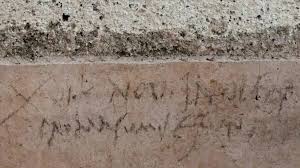When Mount Vesuvius erupted in 79 A.D., Pompeii was tragically devastated. However, the ash that buried the city also preserved a remarkable amount of graffiti, offering a glimpse into the daily life and personal politics of ancient Rome. These inscriptions, found on walls throughout Pompeii, provide a relatable and often raunchy depiction of the city’s inhabitants.
A Vibrant City Frozen in Time
Pompeii, established around 600 B.C., was a diverse and vibrant city in the Roman Empire. Its location on the southern slope of Mount Vesuvius provided fertile soil but also put the city at constant risk of disaster. Just 17 years before the eruption, Pompeii had suffered a devastating earthquake that left it in ruins. After the eruption, Pompeii remained buried until its rediscovery in the 1700s. Since then, archaeologists have uncovered a wealth of Roman graffiti, offering a unique glimpse into the past.
An Array of Graffiti
The graffiti found in Pompeii covers a wide range of topics, much like modern graffiti. Some inscriptions are simple declarations, such as “Gaius Pumidius Diphilus was here,” dating back to 78 B.C. Others are endearing well-wishes, like a message wishing good health to someone named Victoria.
Interestingly, the graffiti also sheds light on how the ancient Romans perceived death. One inscription reads, “Pyrrhus to his chum Chias: I’m sorry to hear you are dead, and so, goodbye!” It reflects a sentiment of bidding farewell rather than seeing death as a final end.
Not all of the graffiti is kind or wholesome. There are insults and even challenges to commit suicide, showcasing the darker side of human nature even in ancient times.
Unveiling Pompeii’s Ancient Brothel
One of the most revealing aspects of Pompeii’s graffiti is found in its ancient brothel. In addition to well-preserved frescoes, the walls of these rooms contain inscriptions that speak volumes about the society of that time. One woman proudly claimed her role as “Murtis Felatris,” or Murtis, Queen Felator. By using a masculine verb for a traditionally feminine act, she subtly challenged societal norms and redefined her role in Pompeii’s society.
According to Washington University professor Rebecca Benefiel, the graffiti “recreates the life of the town” and provides insight into the thoughts and beliefs of the people who lived there.
Rewriting History Through Graffiti
In 2018, excavations in Pompeii’s Regio V area uncovered a charcoal inscription that challenged historians. The inscription was dated “XVI K Nov,” or the 16th day before November, which contradicted Pliny the Younger’s account of the eruption date. This discovery highlighted the potential for Pompeii’s graffiti to rewrite the historical timeline, offering new insights into the eruption and its aftermath.
Today, much of the graffiti visible in Pompeii is protected behind glass, preserving these anacient inscriptions for future generations. While visitors can no longer add to the city’s legacy of wall writing, the graffiti remains as clear and vivid as the day it was written.
